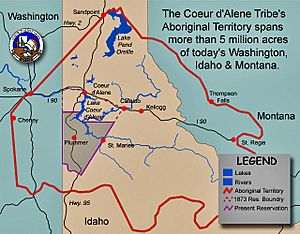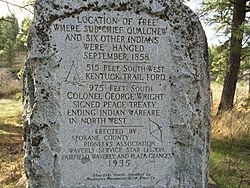Coeur d'Alene War facts for kids
The Coeur d'Alene War of 1858 was a conflict between several Native American tribes and the United States Army. It's also known as the Spokane-Coeur d'Alene-Pend d'Oreille-Palouse War. This war was actually the second part of a larger conflict called the Yakima War. It involved tribes like the Coeur d'Alene (also called Skitswish), Kalispell (Pend d'Oreille), Spokane, Palouse, and Northern Paiute. They fought against U.S. Army forces in what is now Washington and Idaho.
In May 1858, about 1,000 warriors from the Coeur d'Alene, Spokane, and Palouse tribes teamed up. They attacked and defeated 164 American soldiers led by Colonel Edward Steptoe at the Battle of Pine Creek.
After this defeat, a much larger U.S. Army force of 601 men, led by Colonel George Wright, was sent to stop the tribes. On September 1, 1858, Wright's troops defeated the allied tribes at the Battle of Four Lakes. Just four days later, on September 5th, he won another battle against the tribes, who were now joined by the Kalispell, at the Battle of Spokane Plains.
After the Battle of Four Lakes, the army held some Palouse people accountable near Latah Creek. This creek was later called Hangman Creek for a while, though in Washington State, it's now back to Latah Creek. In Idaho, it's still known as Hangman Creek. Among those held accountable was a Yakima chief named Qualchan.
Contents
Why the War Started
Isaac Stevens became the Governor of Washington Territory in 1853. He wanted to build a railroad across the country to the Pacific Northwest. This railroad would help move raw materials from the region to the East. In 1851, Stevens had made many agreements, called treaties, with tribes in the area. His goal was to move Native Americans to special areas called reservations. This would allow settlers to move into the Northwest and build railroads and roads.
These treaties promised the tribes yearly payments. They also guaranteed that the U.S. government would stop white settlers from going onto their assigned lands. However, the Coeur d'Alene people tried to avoid these talks with Stevens. They hoped to keep their traditional lands and not be moved.
The Yakima War's Impact
In the summer of 1855, gold was found near the upper Columbia River. This brought many miners into the area. These miners went onto lands that had been promised to tribes like the Yakima in an earlier meeting (the Walla Walla Council (1855)). This broke the promises made by the U.S. government. The tribes felt angry and betrayed. This anger led to the killing of a U.S. Indian agent, which started the Yakima War. After the local tribes were defeated, Stevens held a peace meeting at Fort Walla Walla in September 1856. This meeting officially ended the Yakima War.
Growing Tensions and Alliances
In 1857, Isaac Stevens left the territory to work in Congress. His leaving upset the tribes who had not yet signed treaties. The Coeur d'Alene people saw that white settlers would eventually move into their area. They worried that without a treaty, they would lose their rights to their ancestral lands. They would have no protection against the settlers. When settlers did start moving onto tribal lands, there was a lot of tension. Small fights broke out, making the tribes fear that the U.S. military would get involved.
A Yakima Chief named Qualchan was still upset about losing the Yakima War. He gathered leaders from the Colville, Coeur d'Alene, Columbia River, and Kalispel tribes. He tried to convince them that white settlers were taking their lands and they needed to defend them. The Coeur d'Alene and other tribes then held their own meeting. They discussed their worries that the army would invade their territory because of the growing tensions.
They decided that if the army crossed the Snake River, it would mean the army was entering their territory. This would be seen as a hostile act. The Coeur d'Alene tribe was divided about going to war. Some leaders, like Chief Vincent, did not want war unless it was absolutely necessary to protect their people. They feared terrible consequences. But younger warriors, led by Melkapsi, were angry and wanted to fight. The Kalispell allies, including war-chief Big Canoe and Spotted Coyote, were ready to fight if needed.
Crossing the Snake River
In early 1858, a miner was killed near Colville, Washington by unknown Native Americans. Because of this, Colonel Edward Steptoe was ordered to lead an expedition. He was to show the strength of the U.S. Army and convince the tribes to hand over those responsible. He left Fort Walla Walla in May 1858, heading for the Colville area. He planned to go through the Coeur d'Alene and Spokane lands.
However, Steptoe only brought 159 soldiers, and they were not well-armed. Steptoe expected help from the Nez Perce and Spokanes. In the past, they had given him boats and men at the Snake River, which was a major obstacle. But this time, Steptoe crossed the Snake River without help. This was the line the tribes had agreed would mean hostility. This action made the tribes believe the army was going to attack them.
The Coeur d'Alene, Palouse (led by Chief Tilcoax), Spokane, and some Yakima warriors gathered to prepare for a fight. Chief Vincent of the Coeur d'Alene demanded to know why Steptoe had trespassed. Steptoe replied they were on their way to Colville. Vincent went back to his camp to try and calm the young warriors who wanted to fight. Steptoe tried to return to Fort Walla Walla.
However, Native American leaders stopped Steptoe and asked him to meet with them. The meeting ended peacefully with a handshake. They agreed Steptoe would leave their territory and take a different route to Colville. But despite this agreement, a frustrated Coeur d'Alene warrior argued with some Nimipu scouts and then shot at them. This started the fighting between Steptoe's men and the Coeur d'Alene, Spokane, and other tribes. Steptoe's men struggled against about 1,000 warriors. Because they were so outnumbered, Steptoe decided to escape that night and return to Fort Walla Walla.
Major Battles and Peace
Colonel Wright led the U.S. troops at the Battle of Four Lakes on September 1. He managed to push back the tribal forces. The tribes fought back on September 5 in the Battle of Spokane Plains. They set fire to the grass and shot at the troops through the smoke. While there wasn't a clear winner, the tribes were greatly weakened.
At this point, the tribes were very divided about continuing to fight. The older leaders saw little chance of winning. Wright then killed over 800 of the tribes' horses that had been captured. This took away the tribes' way to fight and hunt. It showed how far the Army would go to control the tribes. The Coeur d'Alene chiefs realized they could not defeat the Army, especially without their horses. They sent a Coeur d'Alene member to Wright's camp to offer a peace plan.
Peace is Made
Wright arrived to meet with the tribes three days later. They negotiated a peace treaty. The Coeur d'Alene and other tribes agreed to it, understanding they could not defeat the U.S. troops. The treaty required the Coeur d'Alene to return army property. They also had to hand over the individuals responsible for the attack on Steptoe. In the future, they had to allow white people to pass through their lands without trouble. In return, Wright promised there would be no more war against the Coeur d'Alene people.
The tribes handed over those responsible, including Qualchan, who had been a main leader. They were held accountable near Latah Creek. Wright's actions opened the mountain valleys of the Pacific Northwest for white settlement. The tribes were forced onto reservations, which were only a small part of their former lands. There, they quickly faced disease and not enough food.



